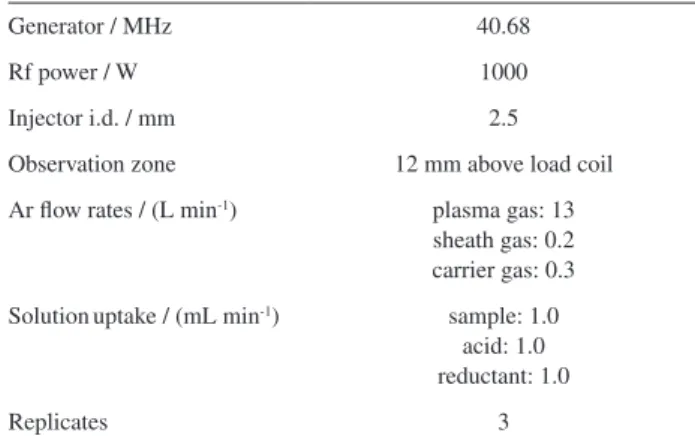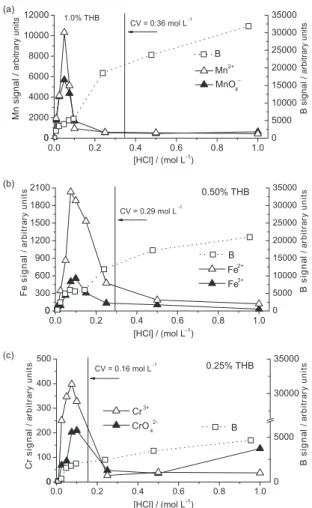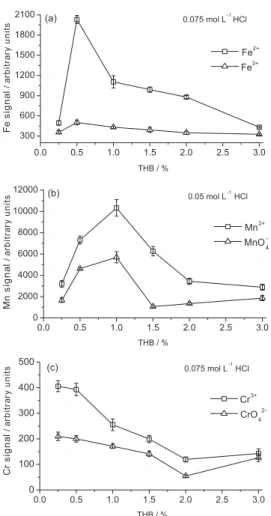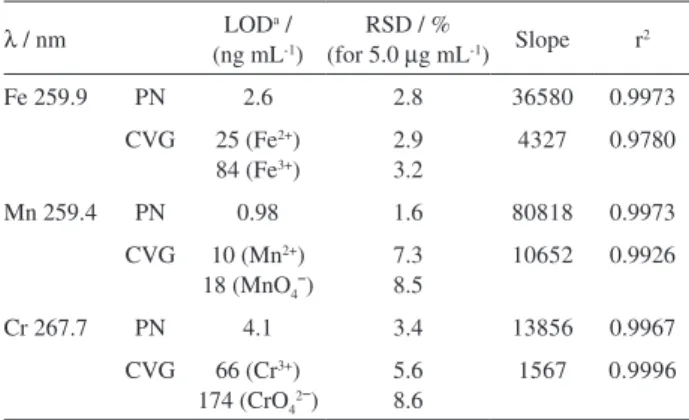Article
J. Braz. Chem. Soc., Vol. 22, No. 6, 1164-1169, 2011. Printed in Brazil - ©2011 Sociedade Brasileira de Química 0103 - 5053 $6.00+0.00
A
*e-mail: wieslaw.zyrnicki@pwr.wroc.pl
Determination of Some Inorganic Species of Fe, Mn and Cr by Chemical Vapor
Generation Hyphenated with Inductively Coupled Plasma Atomic Emission
Spectrometry
Maja Welna, Joanna Lasowska and Wieslaw Zyrnicki*
Wroclaw University of Technology, Chemistry Department, Analytical Chemistry Division, Wybrzeze Wyspianskiego 27, 50-370 Wroclaw, Poland
Este trabalho descreve a geração de espécies voláteis (CVG) dos íons Fe2+, Fe3+, Cr3+, CrO 42ˉ,
Mn2+ e MnO
4ˉ pela reação com o agente redutor NaBH4 em HCl, CH3COOH e ácido cítrico
usando um sistema de separação gás-líquido e espectrometria de emissão óptica em plasma com acoplamento indutivo (ICP OES). As condições otimizadas foram obtidas usando baixas concentrações de HCl (0,05-0,075 mol L-1) e NaBH
4 (0,25-1,0% (m/v)). As espécies voláteis
foram geradas de forma mais eicaz para o estado de oxidação mais baixo dos íons estudados. Limites de detecção de 10, 25 e 66 ng mL-1 foram obtidos para Mn2+, Fe2+ e Cr3+, respectivamente.
Generation of volatile species (CVG) from Fe2+, Fe3+, Cr3+, CrO 4
2ˉ, Mn2+ and MnO 4ˉ ions
by reaction with NaBH4 reductant in HCl, CH3COOH and citric acids using gas-liquid phase
separation system and inductively coupled plasma atomic emission spectrometry detection (ICP OES) was reported. The optimized conditions were obtained using low concentrations of HCl (0.05-0.075 mol L-1) and NaBH
4 (0.25-1.0% (m/v)). Volatile species were more effectively
generated for lower oxidation state of the analytes. Detection limits of 10, 25 and 66 ng mL-1 were
achieved for Mn2+, Fe2+ and Cr3+, respectively.
Keywords: chemical vapor generation, transition metals, speciation forms, inductively coupled plasma optical emission spectrometry
Introduction
In atomic spectrometry, chemical vapor generation (CVG) is a well known sample introduction technique used for determination of hydride-forming elements (e.g. As, Bi, Sb) at trace level.1 Recently, the list of the elements reduced
to volatile species with sodium tetrahydroborate, NaBH4
(THB), in acidic medium, has been meaningfully extended. In the group of transition and noble metals, generation of volatile compounds of Cd,2-5 Cu,3,4,6,7 Ni,3,4,6,8 Zn,2-4,9 Ag,3-6
Au,3,5-7,10 Pd,6,7,10 or Rh6,7 has often been reported. In light of
former research work, experimental parameters including reductant-acid combination (especially the type of acid and its concentration2-10 and THB concentration3,5-9) were found
to inluence the eficiency of the CVG processes. However, chemical vapor generation of transition and noble metals is far from being “mature”, mainly due to the instability of the volatile species.
Concise review devoted to transition metal was presented lately by Matoušek.11 Reports which focus on
applying CVG processes to produce volatile species of Fe, Mn and Cr are scarce. Wickstrøm et al.12 were the irst
who considered transport of the Fe3+ and Cr3+ ions into
plasma at THB-HCl condition. They showed that it is due to transport of the ine aerosol. Pohl and Zyrnicki13 reported
enhanced sample introduction eficiencies for Fe and Cr in the reaction with THB and HNO3, whereas transport of
Mn was realized only by an aerosol formation. Similarly, Peña-Vázquez and co-workers,3 during their interference
study on Ag, Au, Cd, Cu and Ni vapor generation at the one
optimized condition (HNO3 + THB + 8-hydroxyquinoline),
obtained volatile species of Fe and Cr. Dos Santos etal.14
investigated a novel approach to the generation of Hg vapor and additionally tested applicability of this procedure to vapor generation of other metals (including Cr, Fe, Mn). Feng et al.6 were the only ones who mentioned the existence
of volatile Mn species generated from Mn2+ in the reaction
Considering a lack of information on study of speciation forms (appearing in various oxidation states) of transition metals by the CVG application, the studies of the reactions of the ions of Fe (Fe2+, Fe3+), Mn (Mn2+, MnO
4ˉ) and Cr
(Cr3+, CrO
42ˉ) with THB in different acidic media were
undertaken here by means of a CVG ICP OES (chemical vapor generation and inductively coupled plasma atomic emission spectroscopy, as detection method) hyphenated system. The influence of experimental conditions on analytical performance was investigated. Some analytical igures of merit as detection limit, linearity range and precision were evaluated.
Experimental
Chemical vapor generation
Vapors were generated in a continuous low system with a gas-liquid phase separation. A scheme illustrating the system of chemical vapor generation coupled to the ICP OES spectrometer is shown in Figure 1.
The system consisted of a modiied cyclonic spray chamber, a concentric pneumatic Meinhard nebulizer and peristaltic pumps with delivery tubes. The chamber was directly connected with a plasma torch. Sample and acid were simultaneously pumped in two separate streams to the irst Y-junction and then were mixed with reductant solution in the second Y-junction. Then, through a 60 mm long tube (0.5 mm i.d.) the reaction mixture was introduced at the bottom of the chamber. Volatile species and other gaseous coproducts were swept by a carrier Ar stream, introduced through the nebulizer gas inlet, and transported into the plasma. The sample inlet of the nebulizer was clogged. The wastes were drained with the aid of a peristaltic pump. To achieve stability, the level of the post-reaction liquid in the chamber was controlled and kept at a constant level. The
same chamber and nebulizer were also used to nebulize the sample solution.
Apparatus
Measurements were performed using the Jobin Yvon sequential inductively coupled plasma emission spectrometer (JY 38S). Working parameters for CVG and ICP OES detection are listed in Table 1. After the reaction mixture passed into the chamber, 2 min were necessary to achieve steady signals of the analyzed species.
Reagents and chemicals
All chemicals used were of analytical grade. The 1000 µg mL-1 solutions of Fe2+, Fe3+, Mn2+, MnO
4ˉ,
Cr3+ and CrO
42ˉ were prepared from their salts (POCh,
Gliwice, Poland). Working standard solutions (up to 100 µg mL-1 for calibration curves and 5 µg mL-1 for other
investigations) were obtained by dilution of the single-element standards. Solutions of hydrochloric and acetic
acids were prepared from concentrated HCl, CH3COOH
(Merck, Darmstadt, Germany) and citric acid from solid C6H8O7•H2O (POCh) reagent. The reductant solutions
were made daily by dissolving THB powder (POCh) in
0.1 mol L-1 NaOH (POCh). Solutions were iltered before
being used. Deionized water (18.3 MΩ cm) was used in all experiments.
Results and Discussion
The line intensities were expressed here as net intensities (total signal intensity minus background intensity). The mean values were obtained from three repeated measurements with the relative standard
Figure 1. Scheme of chemical vapor generation system: (1) to the ICP OES, (2) Meinhard nebulizer (Ar carrier gas low of 0.3 L min-1),
(3) sample (low rate of 1 mL min-1), (4) acid (low rate of 1 mL min-1),
(5) reductant (low rate of 1 mL min-1), (6) peristaltic pump, (7) reaction
coil, (8) phase separator (modiied cyclonic spray chamber) and (9) drain.
Table 1. The CVG ICP OES operating parameters
Generator / MHz 40.68
Rf power / W 1000
Injector i.d. / mm 2.5
Observation zone 12 mm above load coil
Ar low rates / (L min-1) plasma gas: 13
sheath gas: 0.2 carrier gas: 0.3
Solutionuptake / (mL min-1) sample: 1.0
acid: 1.0 reductant: 1.0
Replicates 3
Wavelength / nm: Feb 259.9, Mnb 259.4, Crb 267.7, Ba 249.7, Mgb 280.3
deviations (RSDs) ranged from 2 to 15%, depending on the experimental conditions.
Reaction of Fe, Mn and Cr ions with THB in HCl medium
The reactions of THB with the ions: Fe2+ and Fe3+, Mn2+
and MnO4ˉ, Cr3+ and CrO42ˉ in HCl, were studied. It was
found that, Fe, Mn and Cr analyte signals were observed only at low concentrations of HCl (< 0.1 mol L-1). It was
also found that, Fe, Mn and Cr analyte signals depended on the HCl acidity and oxidation state of the elements (Figure 2). The signals from Fe2+, Mn2+ and Cr3+ were
2-4 times higher than those achieved from Fe3+, MnO 4ˉ
and CrO4
2ˉ. Such behaviour is similar to that observed for
hydride-forming elements (e.g. As, Sb, Se). The reasons for the higher signal for lower oxidation state of transition elements are complex and likely attributed mainly to changes in the kinetics of the reaction of ions with THB.
To demonstrate that Fe, Mn and Cr are transported to ICP as volatile species, and not as a ine aerosol formed in the chamber due to a turbulent reaction between THB and
acid, the sample solutions were spiked with 10 µg mL-1 of
Mg. Magnesium is considered to be an element which does not form any volatile compounds with THB and is only transported in aerosol form. According to our previous work,15 boron is transported to plasma in the same way.
Behavior of the B and Mg signals on one side and the Fe, Mn and Cr signals on the other side was quite different. For clarity, only the analyte and boron lines were shown in Figure 2. The generation of Fe, Mn and Cr species took place only at low acidity, where reaction between the reductant and acid runs less violently. At higher turbulence, the Mg and B lines were more intensive, but analyte line intensities decreased drastically. Additionally, the CVG reactions with Fe2+ and Mn2+ ions were conducted
in the presence of EDTA (a strong complexing agent). Suppression of the analyte responses was also observed. These results are clear evidence that Fe, Mn and Cr signals arise due to a chemical process. Transport of aerosol introduced with the gas phase into plasma during the CVG reaction was very small and depended on experimental conditions. For magnesium, it was measured to be about 0.005% in the range of volatile species generation, and at high turbulence of CVG reactions (1% (m/v) THB with 1mol L-1 HCl) it did not exceed 0.01%.
Conditions for the generation of Mn, Fe and Cr vapors differed significantly from those for hydride-forming elements. The highest responses (Figure 2) were obtained much before the so called CV point (critical value), corresponded to the point at which the equivalent of acid is equal to the sum of THB + NaOH. Our results for Fe, Mn and Cr are in agreement with those reported as mild conditions for CVG, in the case of the transition metals.6-9
Effect of THB concentration in HCl medium
Vapor generation from Fe, Mn and Cr ions, with 0.25-3.0% (m/v) THB and 0.01-1.0 mol L-1 HCl, was
examined. The results are given in Figure 3.
The dependencies of the Mn, Fe and Cr signals on the THB concentration were characteristic for each metal and were also similar among metal forms. Reaction runs more effectively for the lower oxidation states of the metals. The maximum signals of the Fe, Mn and Cr were found at different THB concentrations, but at similar HCl concentrations, i.e. 0.05-0.075 mol L-1.
The Fe signal (Figure 3a) increased up to 0.5% (m/v) THB. Above this concentration the Fe emission decreased. For Fe2+ changes were signiicant and rapid. Reduction of
Fe3+ was less eficient. In the region of 1-2% (m/v) THB,
the Fe2+ signal was about 3 times higher than that from Fe3+.
The Mn signal from Mn ions (Figure 3b) increased with
the THB concentration. The highest Mn line intensity was obtained at 1.0% (m/v). Further growth in THB amounts caused a continuous decrease in the Mn signal for Mn2+,
and a rapid for MnO4ˉ. The response obtained from MnO4ˉ
was, on average, ca. 2.5 times lower than the response from Mn2+.
The relationships for Cr were quite different (Figure 3c). It was found that Cr volatile species could be effectively generated only at a very low THB concentration. The highest responses from Cr3+ and CrO
42ˉ were attained at a THB
concentration of 0.25% (m/v). For the higher THB amounts, the Cr signal was systematically reduced. The Cr3+ signal
was around 2 times higher than that of the CrO4
2ˉ signal.
Summarizing, the 0.5, 1.0 and 0.25% (m/v) THB concentrations were observed here, as optimal for generation of the volatile Fe, Mn and Cr species, respectively.
Investigation of the HCl-THB effect on chemical vapor generation eficiencies of Fe, Mn and Cr species indicates that both HCl and THB are critical variables. As it was shown in Figures 2-3 the optimized conditions are different for all the elements investigated here. Generally, at selected and ixed HCl concentration we initially observed appearing
of distinct signal maximum increasing with concentration of THB. With further growth in THB concentration, signal maximum disappeared and the relation between analyte responce and HCl concentration was typical for aerosol transport to plasma.
Effect of acid type and concentration
The effect of the HCl, CH3COOH and citric acid on the
analytes responses was studied in a concentration range of 0.01 to 1.0 mol L-1. An optimal THB concentration for
Fe, Mn and Cr species generation were used. The results showing the highest reactivities for lower oxidation states of the metals were collected and compared in Figure 4.
HCl was found to be the most favourable medium. At a concentration of 0.075 mol L-1 for Fe2+ and Cr3+, and
at a concentration of 0.05 mol L-1 for Mn2+, the highest
intensities of Fe, Mn and Cr lines were reached. At such conditions, the responses from Fe3+, MnO
4ˉ and CrO4 2ˉ were
4.2, 1.8 and 2.2 lower than those of Fe2+, Mn2+ and Cr3+.
For CH3COOH, the highest responses from Fe
2+ and Mn2+
were obtained at a concentration of 0.075 mol L-1, but their
signals were 2-3 times lower than those obtained in HCl. In citric acid, the maximum of the Fe signal was shifted towards
lower acidity. The maximum was reached at a concentration of 0.025 mol L-1. In such a citric acid concentration, the Fe2+
response was 2 times lower in comparison to the signal obtained in 0.075 mol L-1 HCl. The Mn signal in citric acid,
as well as the Cr signals in acetic and citric acids, were not suficiently intensive to be measured.
Summarizing, HCl acid was found to be the best reaction medium for Fe, Mn and Cr volatile species generation.
Effect of the sample, acid and THB low rates
The inluence of the low rates, of the reagents (i.e. sample, acid and reductant) on the analyte signals during
Figure 3. Effect of the THB concentration on intensities of Fe (a) Mn (b) and Cr (c) species under chemical vapor generation condition.
Figure 4. Effects of HCl, CH3COOH and citric acids on signals from Fe2+,
Table 2. Analytical performance using pneumatic nebulization and chemical vapor generation in optimized conditions for Fe, Mn and Cr species detection
λ / nm LOD
a /
(ng mL-1)
RSD / %
(for 5.0 µg mL-1) Slope r2
Fe 259.9 PN 2.6 2.8 36580 0.9973
CVG 25 (Fe2+)
84 (Fe3+)
2.9 3.2
4327 0.9780
Mn 259.4 PN 0.98 1.6 80818 0.9973
CVG 10 (Mn2+)
18 (MnO4ˉ)
7.3 8.5
10652 0.9926
Cr 267.7 PN 4.1 3.4 13856 0.9967
CVG 66 (Cr3+)
174 (CrO42ˉ)
5.6 8.6
1567 0.9996
a3σ criterion; n = 3.
Figure 5. Calibration graphs for Fe2+, Mn2+ and Cr3+ ions at the application
of vapor generation.
vapor generation from the Fe2+ Mn2+ and Cr3+ ions, was
examined. It was found, that an increase in the low rates from 0.25 to 1.0 ml L-1 led to a 6-fold enhancement of the
signals. Above this point, the signals started to decrease and the repeatability of the measurements became poorer. Such an effect was probably due to a larger production of H2, leading to instability of plasma. As a result, the reagent
low rates of 1.0 ml L-1 were used here.
Effect of the reaction coil length
Maximum Fe2+, Mn2+ and Cr3+ responses were observed
if the reaction coil was short. In our case it was a 6 cm coil. An increase in the coil length of up to 60 cm caused a 5-fold decrease in analyte signals.
Analytical performance
Under optimized CVG conditions, the analytical igures of merit for Fe, Mn and Cr species, i.e. the limits of detection (LOD), linear dynamic ranges (LDR), linearity coeficients (r2), slopes of calibrations (a) and precision
of measurements of analytes signal (expressed by RSD)
were examined. The LOD, RSD and r2 values as well as
the slope coeficients are listed in Table 2. Table 2 includes also some results achieved for pneumatic nebulization (PN). Calibration graphs for Fe2+, Mn2+ and Cr3+ were shown in
Figure 5.
Linearity of the Mn2+ and Cr3+ signals was observed to
100 µg mL-1, although in the case of chromium two linear
ranges could be distinguished. The Fe2+ signal was linear
only up to 5 µg mL-1. After that, the Fe2+ response was not
proportional, and appearance of a black precipitate in the reacting mixture occurred.
The RSD values, noticed at chemical vapor generation from Mn2+ and Cr3+, were higher than those observed when
applying pneumatic nebulization for measuring Mn and Cr by ICP OES. Precisions of the ICP OES measurements of Fe using the CVG and PN technique were similar. For the CVG process the RSD values were dependent on the analyte concentration.
The LODs were about 2-3 times lower, on average, for the Fe2+ Mn2+ and Cr3+ than those for Fe3+, MnO
4ˉ and
CrO4 2ˉ
. The obtained values were about one order higher than
those for PN. Eficiency of chemical vapor generation was calculated by comparison of CVG slopes with PN slopes. At a 2% eficiency of nebulizer-cyclonic chamber system used here, the following eficiency values were obtained: 0.26% for Mn2+, 0.24% for Fe2+ and 0.23% for Cr3+.
Our results for Feand Cr are dificult to compare with those reported by Peña-Vázquez et al.3 due to different
experimental conditions applied in our investigation. Nevertheless, our LOD values were 3 times higher for Fe but 4 times lower for Cr.
Conclusions
For the irst time, an investigation of chemical vapor generation of volatile species from Fe2+, Fe3+, Cr3+, CrO
42ˉ,
Mn2+ and MnO
4ˉ ions in the reaction with THB in acidic
media was demonstrated. Efficiencies of the volatile species formation were higher for lower oxidation states of metals. The optimal CVG conditions were far from typical conditions for hydride-forming elements in the borohydride generation technique. The inluence of the experimental parameters on the response of the Fe, Cr and Mn analytes was very signiicant and stronger than in the case of such elements as e.g. As, Bi or Sb. The high effectiveness of the CVG process was observed for relatively narrow ranges of HCl (from 0.05 to 0.075 mol L-1) and THB (0.5-1.0% (m/v))
References
1. Pohl, P.; Trends Anal. Chem. 2004, 23, 87.
2. Sun, H.-W.; Suo, R.; Anal. Chim. Acta 2004, 509, 71. 3. Peña-Vázquez, E.; Villanueva-Alonso, J.; Bermejo-Barrera, P.;
J. Anal. At. Spectrom. 2007, 22, 642.
4. Villanueva-Alonso, J.; Peña-Vázquez, E.; Bermejo-Barrera, P.; Spectrochim. Acta, Part B 2009, 64, 659.
5. Cankur, O.; Yavuz Ataman, O.; J. Anal. At. Spectrom. 2007, 22, 791.
6. Feng, Y.-L.; Lam, J. W.; Sturgeon, R. E.; Analyst 2001, 126, 1833.
7. Feng, Y.-L.; Sturgeon, R. E.; Lam, J. W.; J. Anal. At. Spectrom. 2003, 18, 1435.
8. Marrero, J.; Smichowski, P.; Anal. Bioanal. Chem. 2002, 374, 196. 9. Smichowski, P.; Farías, S.; Pérez Arisnabarreta, S.; Analyst
2003, 128, 779.
10. Pohl, P.; Zyrnicki, W.; J. Anal. At. Spectrom. 2001, 16, 1442. 11. Matoušek, T; Anal. Bioanal. Chem. 2007, 388, 763. 12. Wickstrøm, T.; Lund, W.; Bye, R.; Analyst 1996, 121, 201. 13. Pohl, P.; Zyrnicki, W.; Anal. Chim. Acta 2001, 429, 135. 14. dos Santos, E. J.; Herrmann, A. B.; Azzolin Frescura, V. L.;
Sturgeon, R. E.; Curtius, A. J.; J. Braz. Chem. Soc. 2008, 19, 929. 15. Welna, M.; Zyrnicki, W.; Anal. Lett. 2008, 41, 2759.
Submitted: November 26, 2010



